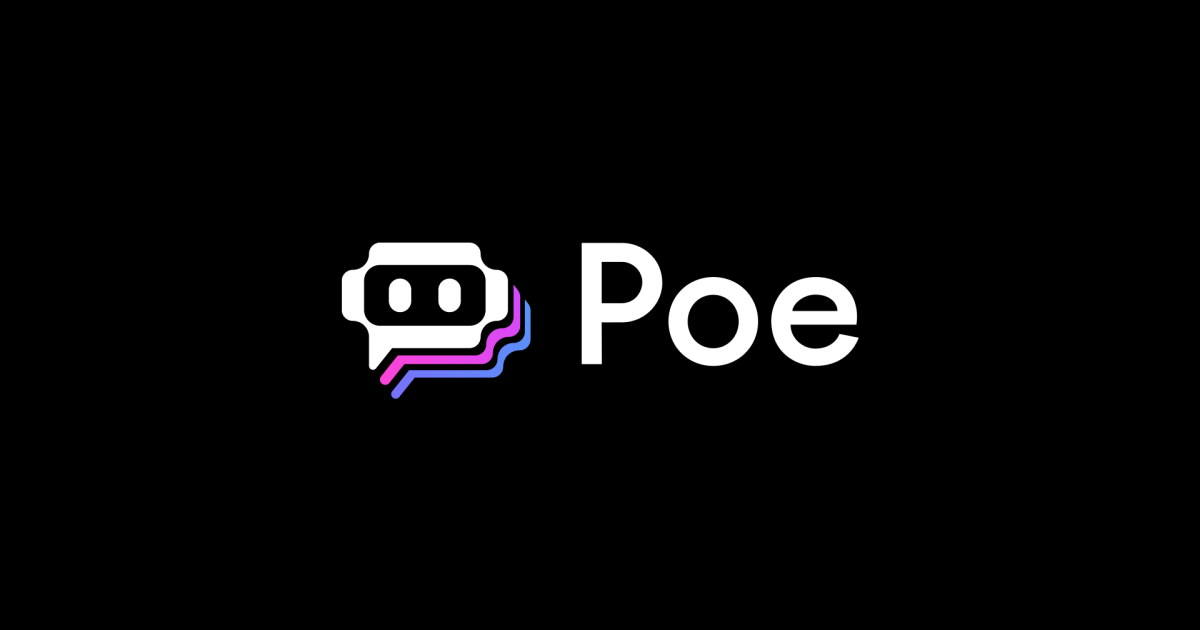Key Takeaways
What is Poe? Poe is an AI chatbot aggregator platform that centralizes multiple advanced AI models (like GPT-4.5 and Claude 3.7) in a single interface, eliminating the need to switch between services while providing a streamlined experience.
- 🔄 Allows seamless switching between AI models mid-conversation without losing context
- 🚀 Emphasizes fast response times across all integrated models
- 🧠 Includes specialized AI capabilities beyond text (Runway for visual AI, ElevenLabs for audio)
- 🌐 Works across web browsers and dedicated mobile apps for anywhere access
- 🧩 Features a vast ecosystem of specialized bots beyond core models
- ⚙️ Employs simplified authentication through Google and Apple sign-in
- ⚠️ May offer less in-depth customization than accessing each AI model directly
This review covers: features, integrations, customization, platform availability, pricing, pros and cons, and real-world use cases.
What is Poe?
Poe is an AI chatbot aggregator platform that centralizes access to multiple AI language models and assistants in a single interface. The service allows users to interact with various AI systems without maintaining separate accounts across different platforms, creating a more streamlined experience for those who rely on AI assistance for diverse tasks.
Use Cases
🔎 Research and Information Gathering
- 📚 Academic research assistance using models like Claude 3.7 Sonnet for nuanced explanations of complex topics
- 📊 Market research and competitive analysis through structured conversations with specialized models
- 📑 Literature reviews and summarization of academic papers with citation capabilities
✍️ Content Creation and Editing
- 📝 Creative writing assistance with story development, character creation, and dialogue generation
- 🎯 Copywriting for marketing materials, product descriptions, and promotional content
- 🖋️ Document editing with grammar correction, style suggestions, and tone adjustments
🛠️ Professional and Technical Support
- 💻 Programming assistance and code generation using models optimized for software development
- 💼 Business strategy planning and problem-solving through conversational brainstorming
- 📋 Technical documentation creation and improvement for products and services
🧠 Learning and Education
- 🎓 Personalized tutoring in various subjects with models best suited for educational content
- 🗣️ Language learning practice through conversation with AI assistants
- 🔍 Concept explanation and simplification for complex topics across different fields
⏱️ Productivity Enhancement
- 📧 Email drafting and communication assistance for professional correspondence
- 📅 Meeting preparation with agenda creation and talking points development
- ✅ Task management and personal organization through conversational planning
The ability to quickly switch between different AI models makes Poe particularly valuable for users who need to leverage the unique strengths of various models for different aspects of their work or personal projects.
Supported AI Models and Integration
🤖 Which models does Poe include? Poe offers integration with GPT-4.5, Claude 3.7 Sonnet, DeepSeek-R1, Runway, and ElevenLabs, representing some of the most advanced AI models currently available.
🔄 How do the models complement each other? Each integrated model brings distinct capabilities: GPT-4.5 offers versatility across tasks, Claude 3.7 Sonnet excels at nuanced understanding and reasoning, while DeepSeek-R1 provides specialized capabilities for particular query types.
🎨 Does Poe support non-text AI? Yes, the platform extends beyond text with Runway for visual AI capabilities (image and video creation) and ElevenLabs for voice synthesis and audio generation.
💡 Ecosystem Advantage: Poe appears to provide access to a vast ecosystem of AI bots, suggesting support for custom or community-created specialized assistants beyond the foundation models.
Ease of Use
🧩 What’s the user interface like? Poe employs a clean, conversation-focused design that follows familiar messaging app patterns, making it intuitive for most users while keeping interactions with AI models front and center.
🔄 How does model switching work? Switching between different AI models appears straightforward, allowing users to leverage various assistants’ unique strengths without disrupting their workflow – particularly valuable when one model isn’t optimal for the current task.
🔑 How easy is account creation? Authentication through Google and Apple sign-in methods simplifies the onboarding process, reducing friction for new users without requiring yet another unique password.
⚡ Speed Focus: The platform emphasizes fast responses, which contributes significantly to productivity by maintaining user concentration during AI interactions.
Customization Options
⚙️ What basic customization is available? While specific details aren’t provided, AI platforms typically offer adjustments to response length, formality level, and creative freedom as standard customization options.
💾 How does memory management work? Effective AI platforms allow control over conversation history retention, whether information should persist across sessions, and how previous interactions inform future responses.
👤 Can users create specialized assistants? Advanced customization might enable users to create specialized assistants for recurring tasks, though Poe’s specific capabilities in this area aren’t detailed in the provided information.
📝 Model-Specific Settings: For platforms hosting multiple AI models, setting preferences for each model separately can enhance efficiency by leveraging each assistant’s particular strengths.
Response Quality and Consistency
📊 What makes for high-quality AI responses? Quality responses demonstrate accuracy, relevance to queries, appropriate depth, and clear formatting. By providing access to models like GPT-4.5 and Claude 3.7 Sonnet, Poe appears to prioritize these aspects.
🔄 How do different models compare? Different AI models excel in different domains – Claude models are recognized for nuanced understanding and measured responses, while GPT models are known for versatility and creative capabilities.
🧠 How is context managed when switching models? For multi-model platforms, maintaining conversation context when switching between different AI assistants is critical for a cohesive experience without starting from scratch.
📋 Consistency Factors: Users benefit when formatting, citation practices, and error handling remain consistent regardless of which assistant they’re using.
Speed and Performance
⚡ How fast are responses? Poe specifically highlights “Fast” as a key feature, suggesting the platform prioritizes quick response times across its various integrated models.
⏱️ What affects response time? Response latency (time between query and answer) is most noticeable to users, who typically expect responses within seconds for simple queries, though complex requests may reasonably take longer.
🔄 Are speeds consistent across models? For aggregator platforms like Poe, performance may vary between models. Transparent information about expected response times helps manage user expectations.
🛠️ Reliability Factors: Beyond raw speed, stability, consistent uptime, minimal errors, and graceful handling of high-traffic periods all contribute to perceived performance quality.
Access and Platform Availability
💻 How can users access Poe? Poe offers web access with mobile application support, providing flexibility for different usage scenarios across devices and operating systems.
🌐 What are the benefits of web access? Web browser access provides the broadest compatibility across devices, allowing usage from any computer regardless of operating system – valuable for users who switch between devices or work in restricted environments.
📱 Why is mobile support important? Mobile applications extend Poe’s utility to on-the-go scenarios, enabling users to consult AI assistants from smartphones and tablets for quick reference queries or continuing conversations started elsewhere.
🔄 Cross-Platform Experience: Seamless synchronization of conversation history, saved prompts, and user preferences across platforms enhances continuity when switching between devices.
Privacy and Data Security
🔒 Why is privacy important for AI platforms? Users often share sensitive personal or professional information during AI interactions, making responsible data handling essential for establishing trust.
📝 What should privacy policies cover? Comprehensive policies address data collection scope, conversation storage practices, retention periods, and whether interactions are used to train AI models.
🔐 What security measures matter? Strong encryption for data in transit and at rest, secure authentication methods, regular security audits, and clear incident response procedures contribute to a robust security posture.
🛡️ User Control: Effective privacy controls give users agency through options to delete conversation history, download personal data, and opt out of certain data collection types.
Pricing Structure and Free Usage Limits
💰 What makes for effective AI platform pricing? Balanced pricing typically includes free tiers with reasonable usage limits for casual users and students, plus premium subscriptions with enhanced capabilities for professionals.
🔄 How do multi-model platforms handle pricing? For aggregators like Poe, pricing complexity increases as different underlying models have varying costs – some services address this through model-specific allocations within subscription tiers.
⭐ What features differentiate pricing tiers? Beyond basic access, value-added features often include enhanced customization, priority processing, advanced data export, professional tool integration, and team collaboration capabilities.
📊 Value Assessment: Transparent communication about what’s included in each tier helps users make informed decisions about which option best meets their needs and budget.
User Support and Documentation
📚 What documentation helps new users? Clear onboarding guides and basic tutorials help establish comfort with the platform’s interface and core functions for beginners.
🔍 What resources benefit advanced users? Detailed documentation about model capabilities, parameter settings, and advanced techniques enables experienced users to maximize the platform’s utility for specialized tasks.
💬 What support channels are effective? Comprehensive support spans searchable knowledge bases, interactive tutorials, email support for complex issues, and possibly chat or phone support for premium users.
👥 Community Support: Moderated forums, discussion groups, or community Q&A sections enable users to share techniques, troubleshoot issues, and discover creative applications.
Community and Third-party Bot Ecosystem
🔍 How do users discover bots? Effective ecosystems offer discovery mechanisms with categories, ratings, or recommendations to help users find relevant bots or models for specific tasks.
🛠️ Can users create custom bots? Creation tools enable users with varying technical skills to develop custom assistants, from simple prompt customization to more complex fine-tuning.
🔄 How are community bots shared? Sharing capabilities allow creators to distribute their bots either publicly or within specific communities or organizations.
🌐 Extended Engagement: Community interaction often extends beyond the platform to include discussion forums, social media groups, or dedicated events where users exchange ideas and showcase projects.
Summary
- 🔑 Poe centralizes multiple AI models in one interface, eliminating the need to manage separate accounts across different AI platforms
- ⚙️ Quick-switching between models enables leveraging each AI’s strengths for different tasks within the same workflow
- 💡 Supports diverse use cases from research and content creation to programming and education
- ✅ Emphasis on speed, cross-platform access, and interface simplicity makes AI assistance more accessible
- ❌ May offer less control over model-specific parameters compared to accessing each AI service directly
- ✅ Single login provides access to multiple leading AI models
- ✅ Web and mobile interfaces allow anywhere access
- ✅ Fast response times maintain workflow momentum
- ✅ Seamless model switching adapts to different task requirements
- ✅ Simplified authentication through Google and Apple accounts
- ✅ Beyond-text capabilities with visual and audio AI integration
- ❌ Potential limitations in model customization depth
- ❌ Possible inconsistencies in performance between different models
- ❌ May lack some advanced features available on original model platforms
- ❌ Pricing structure complexity with multiple integrated models
- ❌ Dependency on third-party AI providers for core functionality
Frequently Asked Questions
What makes Poe different from using individual AI chatbots directly?
Poe aggregates multiple AI models in a single interface, allowing you to access different AI assistants without switching between separate accounts or platforms. This consolidation saves time and streamlines workflows, particularly if you regularly use different models for various tasks. The unified interface maintains consistent conversation history and user experience across models, creating a more cohesive interaction.
Which AI models are available on Poe?
Based on the homepage information, Poe includes integration with several leading AI models including GPT-4.5, Claude 3.7 Sonnet, DeepSeek-R1, Runway, and ElevenLabs. The platform also refers to a vast ecosystem of bots, suggesting access to numerous AI assistants beyond these core models, potentially including specialized or community-created options.
Is Poe available on mobile devices?
Poe appears to offer both web access and mobile applications. The web version provides universal access from any device with a browser, while dedicated mobile apps likely offer optimized experiences for smaller screens and on-the-go usage. The platform seems designed to provide consistent access across different devices, though specific features may vary between platforms.
How does Poe handle user data and conversation privacy?
While specific privacy policies aren’t detailed in the provided materials, AI platforms typically outline their data practices in privacy policies. When evaluating Poe or any AI platform, it’s important to review these policies to understand how conversations are stored, whether they’re used to train AI models, what controls users have over their data, and what security measures protect sensitive information.
Does Poe require a subscription to use?
Detailed pricing information isn’t included in the provided materials. Most AI platforms offer various pricing tiers, often including free options with usage limitations and premium subscriptions with enhanced capabilities or access to more advanced models. The specific cost structure and which features require payment would be detailed on the platform’s pricing page.
Can I create or customize my own bots on Poe?
Based on the reference to a large ecosystem of bots on the homepage, Poe may support custom bot creation or customization. This could range from simple prompt engineering to more complex bot development. Many AI platforms allow users to create specialized assistants that combine base model capabilities with specific instructions, knowledge, or personality traits.
How does Poe compare to other AI chatbot platforms?
Poe’s primary differentiation appears to be its aggregation of multiple leading AI models in a single interface. This approach offers greater versatility than single-model platforms, allowing users to leverage different models’ strengths for various tasks without managing multiple accounts. The platform also emphasizes speed and ease of use, suggesting a focus on practical utility rather than complex customization.
Poe is an AI chatbot platform that brings together multiple advanced language models in one convenient interface. The platform appears to prioritize speed, accessibility, and versatility, providing access to models like GPT-4.5, Claude 3.7 Sonnet, and specialized tools for visual and audio content. With a clean interface that works across web and mobile, Poe eliminates the need to maintain separate accounts on different AI services.
The ability to quickly switch between different AI models allows users to leverage each model’s unique strengths for specific tasks, from creative writing and code generation to research assistance and content editing. This flexibility, combined with the platform’s apparent emphasis on fast response times, creates a productivity-enhancing experience for both casual and professional users.
Ready to try Poe? Visit the official site



